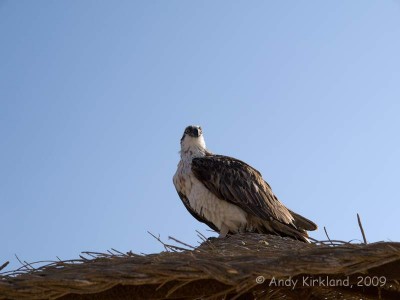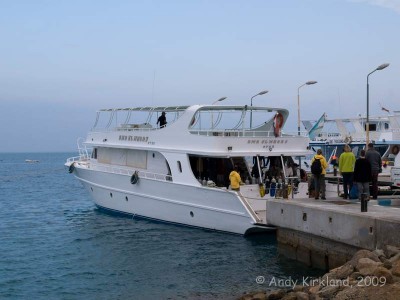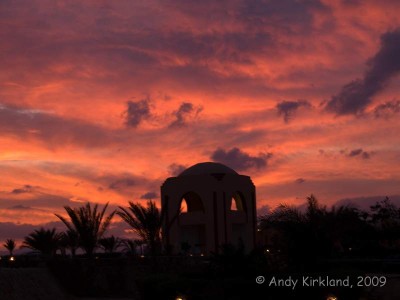Hamata, December 2009
Hamata is about as far south as you can get in the Egyptian Read Sea. My buddy John and I booked with Regal Dive, and flew from Manchester to Marsa Alam. Then there’s a transfer taking about 4 hours. As we were driving down, a full moon rose over the Red Sea – another of those auspicious events that settles me in.
Hotel
We were staying (half board) at the Zabargad Resort Hotel. The rooms were clean, and the food was straightforward, mostly buffets, although there was a barbecue one night. There don’t seem to be many alternatives – you’re 10km or so from Berenis, the nearest town (we didn’t try it). Most people seemed to head straight off to bed after dinner, but Bob’s Bar stays open for a while.
There doesn’t seem to be much for a non-diving partner to do, if they aren’t keen on sunbathing – although there are bird-watching tours, and there’s a Kite Village (as in Kitesurfing) up the road.
There are quite a few wading birds at the marina (spoonbills and heron amongst others) – and also a few wandering round the grounds.
Dive Centre
We dived with Orca divers, who are based on site. The Hamata marina is about 5 minutes drive away, and we’d normally set off at either 8am or 8:30am, depending on the sites. there are a couple of excursions which start out earlier.
Orca have two boats but we were stayed on the “El Masry” all week. The crew were very helpful. I don’t bother with lunches on boat, but I’m told they were well up to standard. We did like the way Orca treated us as “grown up” divers – they gave us a briefing on the site, and we then dived as buddy pairs. So we didn’t have to play “follow my leader” – on some dives, there wasn’t a guide in the water. The remoteness of Hamata means that most (or all) of the clientele are experienced divers. Orca is a German-run operation, so there’s no problem finding a DIN valve. We were diving on 12L steel “dumpy” tanks all week and Nitrox is standard if you’re certified.
Most of the customers are German as well (apart from us, there were a few Dutch). All of the dive staff gave briefings in English as well as German, so we weren’t at all excluded.
The Diving
The dive sites are nearly all on Fury Shoals – a complex of off-shore reefs and pinnacles. This is far more subtle than – say – Sharm, and we felt that it would be best appreciated by divers who’d been to other Red Sea locations. The marine life is recognisably Red Sea, however, albeit that you’ve got to look a bit harder to find it. We felt that Hamata would suit divers who’d already been to most of the more commercial resorts, who would appreciate the differences.
Except for the porites hard corals. Now, I’ve read all of the books and seen the documentaries that tell how these little polyps have been building structures for millennia, but most of the locations I’ve dived could – to be honest – just be rocks with a veneer of corals. On Fury Shoals, though, you’re in no doubt about the amount of work these little chaps have been putting in. And the visibility – which is just huuuuge – only adds to the sense of awe.
These reefs are out in the open sea, though so there can be some strong currents. Orca were pretty good at avoiding them for us, though, so it didn’t spoil our diving.
There were a couple of dives worthy of special mention.
We started off on Sha’ab Ramadan, named after the boats skipper. This is an superb dive and different from all the others. This is two pinnacles, rising from the sea bed at around 30m to about 5m short of the surface. They’re heaving with gorgeous soft corals, and there’s a long-nosed hawkfish down around the bottom. We dived it twice, and both times there was a big swirl of jacks (Herring scad, I think, but there were other species lurking). Sorry no photos as I couldn’t get focus. And there were a couple of nudibranchs.
But, where this is experience can probably be repeated, the second dive – on Sha’ab Zabargad was right our on its own. We were heading along a plateau, with a few bommies to investigate, when a pod of 8 dolphin overtook us. They’d gone before I had a chance to sort my camera – and get over my astonishment. This is really rare on scuba gear, as the bubbles tend to scare them off. John (who’s been diving much longer than me) tells me he’s only ever seen one on scuba before.
I was just about getting used to this – and trying to deal with an especially territorial anemonefish – when I looked up and saw the mother and calf from the pod about 20-30m away. I got some of my settings right, and snapped off a couple of shots. Then – rather annoyingly – something got into my viewfinder. The rest of the pod were right alongside me – but had were past by the time I got my breath. Blessed and privileged.
The following day we had an early start, on one of the “premium” dives – with more dolphins to snorkel with in the interval. This was – by comparison – a bit of a disappointment, as they were heading off by the time I got into the water. Just to clarify – all of these are wild animals, not part of a dolphinarium setup.
We saw Napoleons, a Hawksbill turtle a free-swimming flatworm. We went through the caves in Sha’ab Claudio – coincidentally after reading the Dive Magazine article (Nov ’09) on the flight out.
We’re planning on going back at the end of 2010 …
You can see the photos in the Hamata photo album



 Entries RSS
Entries RSS